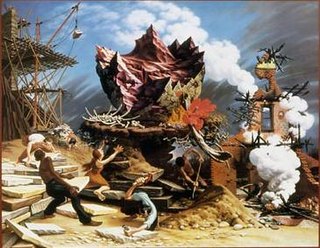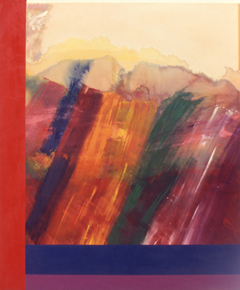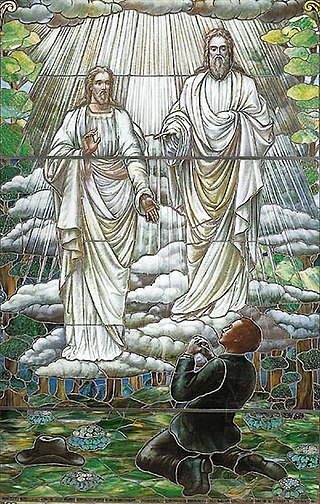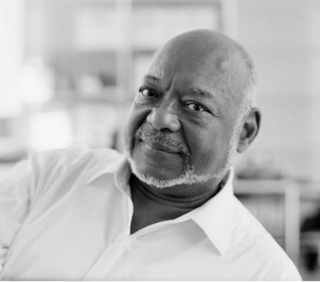Related Research Articles

Stuckism is an international art movement founded in 1999 by Billy Childish and Charles Thomson to promote figurative painting as opposed to conceptual art. By May 2017 the initial group of 13 British artists had expanded to 236 groups in 52 countries.

Albert Bierstadt was a German-American painter best known for his lavish, sweeping landscapes of the American West. He joined several journeys of the Westward Expansion to paint the scenes. He was not the first artist to record the sites, but he was the foremost painter of them for the remainder of the 19th century.

Henri Julien Félix Rousseau was a French post-impressionist painter in the Naïve or Primitive manner. He was also known as Le Douanier, a humorous description of his occupation as a toll and tax collector. He started painting seriously in his early forties; by age 49, he retired from his job to work on his art full-time.

George Wesley Bellows was an American realist painter, known for his bold depictions of urban life in New York City. He became, according to the Columbus Museum of Art, "the most acclaimed American artist of his generation".

Sanford Robinson Gifford was an American landscape painter and a leading member of the second generation of Hudson River School artists. A highly-regarded practitioner of Luminism, his work was noted for its emphasis on light and soft atmospheric effects.

Frank Weston Benson, frequently referred to as Frank W. Benson, was an American artist from Salem, Massachusetts known for his Realistic portraits, American Impressionist paintings, watercolors and etchings. He began his career painting portraits of distinguished families and murals for the Library of Congress. Some of his best known paintings depict his daughters outdoors at Benson's summer home, Wooster Farm, on the island of North Haven, Maine. He also produced numerous oil, wash and watercolor paintings and etchings of wildfowl and landscapes.
John Ford Clymer was an American painter and illustrator known for his nature works featuring the American West.

Frederick Arthur Verner was a Canadian painter, well-known for his paintings of the First Nations in the Canadian west and for his paintings of buffalo. His pictures of the buffalo were thought to be “a class of subject where he stands almost alone and unrivalled,” said Toronto`s The Globe in 1906. Verner set a standard in this department of art, it added in 1908.

Peter Blume was an American painter and sculptor. His work contained elements of folk art, Precisionism, Parisian Purism, Cubism, and Surrealism.

The Art Academy of Cincinnati is a private college of art and design in Cincinnati, Ohio, accredited by the National Association of Schools of Art and Design. It was founded as the McMicken School of Design in 1869, and was a department of the University of Cincinnati, and later in 1887, became the Art Academy of Cincinnati, the museum school of the Cincinnati Art Museum.

Ronnie Landfield is an American abstract painter. During his early career from the mid-1960s through the 1970s his paintings were associated with Lyrical Abstraction, and he was represented by the David Whitney Gallery and the André Emmerich Gallery.
Guy Coheleach is an American wildlife artist. His paintings have been in 41 one-man retrospective exhibitions in major museums in 36 cities from New York to Los Angeles from 1991 to 2011. Along with over a hundred one-man commercial shows worldwide, his work has also been exhibited in the National Collection of Fine Art, the Royal Ontario Museum, the White House, Washington D.C.'s Corcoran Gallery, the Norton Gallery and the Newark Museum.
Terry Isaac was an American painter from Salem, Oregon who was known for his realism paintings of wildlife. In 2007, he moved to Canada.
Karen Latham is an American painter, residing in Hastings, Minnesota. Latham is most known for her realistic miniature paintings of wildlife. Latham is the mother of Bonnie and Rebecca Latham, also painters in the same style.
Zane Lewis is an American visual artist based in Brooklyn, New York. His abstract paintings and sculptures reference color field painting, pointillism, phenomenology, and minimalism. And have been stylistically referred to as 'psychedelic minimalism'.
Leo Valledor (1936–1989) was a Filipino-American painter who pioneered the hard-edge painting style. During the 1960s he was a member of the Park Place Gallery in Soho, New York City, which exhibited many influential and significant artists of the period. He was a leader of the minimalist movement in the 1970s.

Fauvism /ˈfoʊvɪzm̩/ is the style of les Fauves, a group of early 20th-century modern artists whose works emphasized painterly qualities and strong colour over the representational or realistic values retained by Impressionism. While Fauvism as a style began around 1904 and continued beyond 1910, the movement as such lasted only a few years, 1905–1908, and had three exhibitions. The leaders of the movement were André Derain, Maurice de Vlaminck, and Henri Matisse.

Mormon art comprises all visual art created to depict the principles and teachings of the Church of Jesus Christ of Latter-day Saints, as well as art deriving from the inspiration of an artist's LDS religious views. Mormon art includes painting, sculpture, quilt work, photography, graphic art, and other mediums, and shares common attributes reflecting Latter-day Saint teachings and values.
Henry Edison McDaniel was a watercolor artist of landscapes, trout and salmon fishing scenes.

Kynaston McShine was a Trinidadian born curator and public speaker. His visions about contemporary art made lasting contributions to the lives of countless artists and colleagues at the Museum of Modern Art in New York City where he worked from 1959 to 2008. He is said to be the first curator of color at a major American museum and at his retirement he had risen to the position of chief curator at large of painting and sculpture.
References
- 1 2 Wilkinson, Todd. "Taking Wildlife Realism To The Next Level". Daniel Smith. Retrieved 2008-10-23.
- ↑ "Daniel Smith Biography". Greenwich Workshop Publishing. Retrieved 2008-10-23.